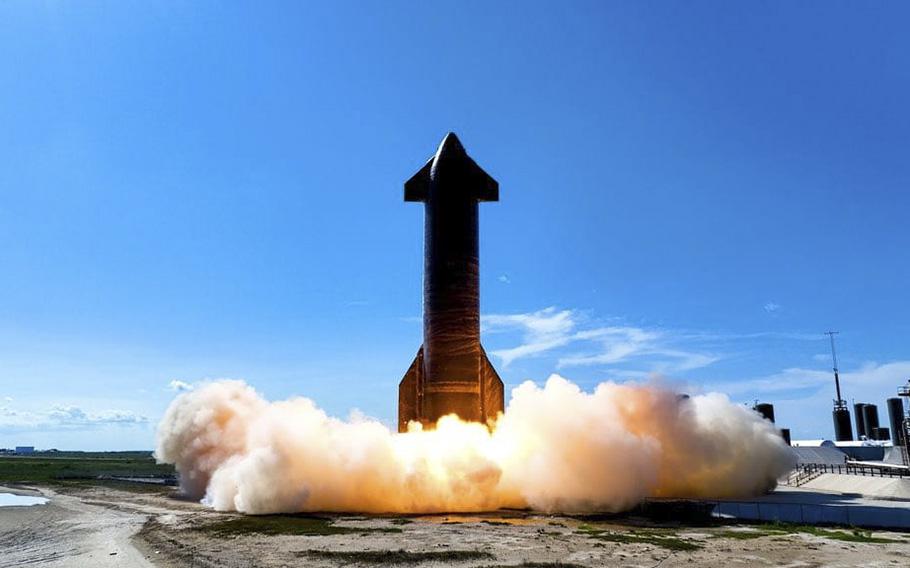
The launch of SpaceX’s massive Starship rocket’s first orbital launch was canceled on Monday, April 17, 2023. (SpaceX/Facebook)
(Tribune News Service) — After the Federal Aviation Administration granted a long-awaited launch license on April 14, all eyes were on Boca Chica Beach/Starbase early Monday morning in anticipation of SpaceX's first attempt to put a Starship into orbit.
The historic launch of the nearly 400-foot-tall integrated Starship SN24 and Super Heavy BN7 booster was scrubbed, however, due to a propellant pressurization issue with the 33-engine Super Heavy.
The weather was ideal for a launch, scheduled to take place at 8:20 a.m., while condensation frost formed along the length of the rocket and white clouds of white vapor vented as super chilled liquid methane and liquid oxygen propellant were loaded onboard.
Everything seemed to be going well until systems monitoring picked up the problem.
"A pressurant valve appears to be frozen, so unless it starts operating soon, no launch today," SpaceX founder and CEO Elon Musk tweeted at 8:11 a.m.
John Insprucker, SpaceX principal integration engineer, narrating a webcast of the event from company headquarters in Hawthorne, Calif., announced shortly after the T minus 17 minute mark (17 minutes until launch) that "the first stage team is working a pressurization issue. They're troubleshooting that right now."
Another problem, as reported by the Coast Guard, was a boat inside the temporary safety perimeter that had to be moved for the launch to be able to take place, he said.
"We cleared several other boats out overnight," Insprucker said. "We're down to one."
At T minus 8 minutes, 43 seconds, he relayed the flight director's decision.
"The decision right now is that we are going to stop the launch for today," Insprucker said. "We're going to transition the launch attempt to a wet dress rehearsal."
The countdown officially stopped at T minus 10 seconds. The wet dress rehearsal entailed fully loading the vehicle with propellant, performing a final alignment of the guidance system, and checking the thrust vector control on both stages — wiggling the engines that control the rocket's direction in flight. A successful WDR was performed in January, followed by a successful static firing of 31 of Super Heavy's engines simultaneously in February.
"The good news is everything's been going good, we're just working that one issue," Insprucker said. "Overall it's been a good day."
It was also a valuable opportunity for the launch team to run through the entire pre-launch sequence once more before the actual flight, he said.
"Learned a lot today, now offloading propellant, retrying in a few days," Musk tweeted after the wet dress rehearsal was finished.
Recycling the propellant takes a minimum of 48 hours, which means another launch attempt won't take place before that, SpaceX said.
The company is developing Starship as a reusable means of transporting humans and cargo to Earth destinations as well as the moon, Mars and perhaps beyond, according to Musk, who says humanity must become multiplanetary in order to guarantee the survival of the species.
NASA awarded a $2.9 billion contract to SpaceX two years ago for development of Starship as a Human Landing System (HLS) for putting U.S. astronauts on the moon again as part of the space agency's Artemis program. Last November NASA announced a $1.15 billion modified contract containing "Option B," involving a more advanced iteration of the Starship HLS that would fly a second crewed demonstration moon landing.
Musk has said Starship likely will fly hundreds of uncrewed missions before carrying humans.
The plan for the first orbital test flight is for Super Heavy's main engines to shut off nearly three minutes after launch and separate from Starship, after which Starship's engines will ignite. Super Heavy will land in the Gulf of Mexico while Starship achieves orbit briefly before splashing down in the ocean about 60 miles north of Kauai, Hawaii, in the Navy's Pacific Missile Range, approximately 90 minutes after launch.
In March Musk estimated that Starship's chances of reaching orbit with the first attempt are "greater than 50 percent."
(c)2023 The Brownsville Herald (Brownsville, Texas)
Visit The Brownsville Herald
Distributed by Tribune Content Agency, LLC.